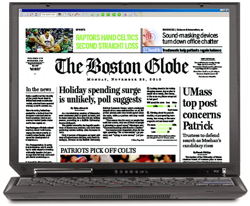 The latest numbers from the Audit Bureau of Circulations, tracking from March 2009 to September 2010, show a major proliferation in the number of e-editions reported by newspapers. Nearly 450 papers currently have weekday e-editions, which tallies to over 2 million subscribers and a 47-percent increase since this time last year.
The latest numbers from the Audit Bureau of Circulations, tracking from March 2009 to September 2010, show a major proliferation in the number of e-editions reported by newspapers. Nearly 450 papers currently have weekday e-editions, which tallies to over 2 million subscribers and a 47-percent increase since this time last year.
As print circulation falls, e-editions swell in numbers. Not so startling. But the data can be misleading: Ballooning e-edition numbers don’t necessarily point to wholesale reader rejection of print, or even widespread usage of e-editions. For some local newspapers, if you want a print subscription, newspapers make it very financially agreeable — and in some cases give you no choice — to throw on an e-edition subscription as well.
Look no further than some of the smaller-market papers that cracked paidContent’s top-25 chart of newspaper e-edition subscriptions. Like, say, number 18, The Bend Bulletin, which grew from 1,108 e-edition subscriptions to 24,611 between Sept. 2009 and Sept. 2010. That’s an increase of over 2,000 percent (!) for a company that doesn’t circulate more than 35,000 weekday papers. But local Bulletin readers don’t even have the option of a print-only subscription, according to the paper’s website: It’s an e-edition or bust.
Or take number 25, The Schenectady Gazette. After launching a free site three years ago, the paper put up a paywall 18 months later and began offering a weekly print-plus-e-edition subscription package for one penny more per day than the print-only option — $3.99 versus $4.00 a week. You’d be hard pressed to find a better way to spend 52 cents a year.
Around the time the Gazette changed its subscription offering, weekly paid print circulation sat at 45,421. By September 2010, that number jumped by 16,052, nearly 35 percent. In roughly that same period, Gazette e-edition circulation increased by 17,796. The paper’s e-edition actually generates ad revenue by proving to potential advertisers that readers are local, Gazette general manager Dan Beck told me. “We have created, in an odd way, a more valuable reader to our advertisers,” Beck said. “We know they are our readers and they are local, they’re from here.”
“My overall sense is that this is more about marketing and new, more favorable metrics for newspaper companies than any kind of dramatic change in reading habits,” says Newsonomics author and Lab contributor Ken Doctor. Indeed, it’s difficult to tell whether e-edition subscriptions equate in any way to usage. Doctor cites “the snowbird reader of a northern paper” as one possible explanation.
The traditional e-edition essentially replicates the print product in digital format; ABC numbers cover these replicas, plus non-replica e-editions, like The Wall Street Journal and the soon-to-be-paywalled New York Times. ABC tracking includes online-only and Kindle subscriptions, which exist on a different account than print subscriptions, and products like TimesReader or GlobeReader as well.
All but two of the top 25 saw percentage increases in that September-to-September period, a phenomenon Doctor partly attributes to the slew of subscription bundles that surfaced over past year. He suggests the conventional e-edition isn’t attractive enough to compete with tablet versions as they continue to improve: “It’s a small, niche product, useful to those who like the newspaper in the format of the print paper. As tablets offer greater choice as digital news reading devices, e-editions will probably wither.”
We’ll see in March 2011, when ABC begins itemizing its e-edition circulation report by weekly subscription versus single-issue purchases, university subscriptions, and mobile readership.